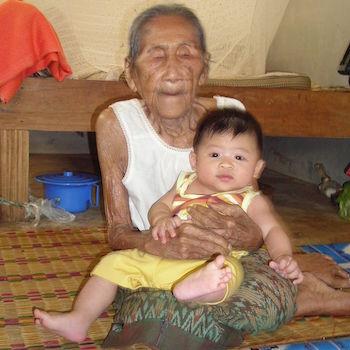For lack of a more sophisticated term, the reason we grow old and die is because our biological tissues “wear out.”
This is a foreign concept to unicellular organisms, such as bacteria, which can grow and divide indefinitely. But this is not the case for cells that dwell within multicellular organisms, like humans. These cells are under tight control and are not allowed to grow or reproduce indefinitely. In fact, a human body cell is allowed to divide only so many times, a boundary known as the Hayflick limit. It is thought that this limit helps prevent cells from growing out of control, in other words, becoming cancerous. This limit probably even applies to stem cells. Therefore, as we age, our organs and immune systems grow weaker, and we eventually meet our demise.
One of the molecular enforcers of the limit on cell division is a structure found on the ends of our chromosomes called telomeres, which can be thought of as similar to the tiny plastic things (called aglets) at the ends of shoestrings1. Every time a cell divides, it must first replicate its DNA-containing chromosomes. This act slightly shortens (and hence, degrades) the telomere, and each subsequent replication shortens it further, somewhat analogous to the way “photocopying a photocopy” slowly degrades the quality of an image. Eventually, the telomeres become so short that any further chromosomal replication could result in the loss of important DNA, and the cell enters a state of “crisis.” In response, the cell commits suicide in a controlled process called apoptosis. Cells that avoid crisis and suicide nevertheless eventually stop dividing. These cells enter a state known as senescence, meaning they are alive but no longer able to reproduce. Senescent cells likely play a role in aging and age-related disease.
It would be logical to conclude that a “fountain of youth,” if it exists, would consist of a medicine or therapy that removed the limit on cell division and prevented cells from entering senescence. These cell lines would essentially be immortal. The good news is that our bodies absolutely can produce immortal cells. The bad news is that they’re cancer cells. As it turns out, there is an inescapable “damned if you do, damned if you don’t” tradeoff that cells face: They can either slowly become old and die, or they can become immortal and cancerous. As one of my former mentors, David Clark, wrote, “Ultimately, your only way of avoiding cancer is to die of something else first!"2
Some people believe that perhaps, one day, we will find a cure for cancer and at least delay our inevitable fate. This is likely too optimistic. While there is no conspiracy by the FDA or Big Pharma to prevent a cure for cancer (see more on this in the next section), there is a conspiracy among cancer cells that prevents us from obliterating them. Just like bacteria, cancer cells can develop resistance to the drugs that target them. Furthermore, what we call “cancer” is actually a collection of hundreds or even thousands of different diseases. While all cancers arise due to mutations in DNA, they often have different underlying genetic profiles. That means, for instance, that one woman’s breast cancer may have a different genetic profile than another woman’s, perhaps necessitating a different type of treatment. (In the future, instead of classifying cancer by tissue of origin – such as lung or pancreatic cancer – it may be far more rational therapeutically to classify it based on genetic similarity3.)
The bottom line is that while we may eventually discover cures for certain types of cancer, there almost certainly will be no universal cure for cancer.
Read Part I: The Riemann Hypothesis
Read Part III: Willful Ignorance
References
(1) Robert A. Weinberg. The Biology of Cancer. 2nd edition. New York: Garland Science. (2014)
(2) David P. Clark and Lonnie D. Russell. Molecular Biology Made Simple and Fun. 3rd edition. St. Louis: Cache River Press. (2005)
(3) Christopher Gerry. “What’s In A Name? The Hidden Complexities Of Classifying Cancer.” American Council on Science and Health. Published: 8-Jul-2019. Accessed: 28-Dec-2019. https://www.acsh.org/news/2019/07/08/what%E2%80%99s-name-hidden-complexi...




